One of the biggest threats we face today is earthquakes. It isn’t just the “Big One” in California, either. Earthquakes can hit anywhere, even outside of fault zones.
Despite the risk, few people know how to survive and prepare for an earthquake.
Surviving an Earthquake Top Tips
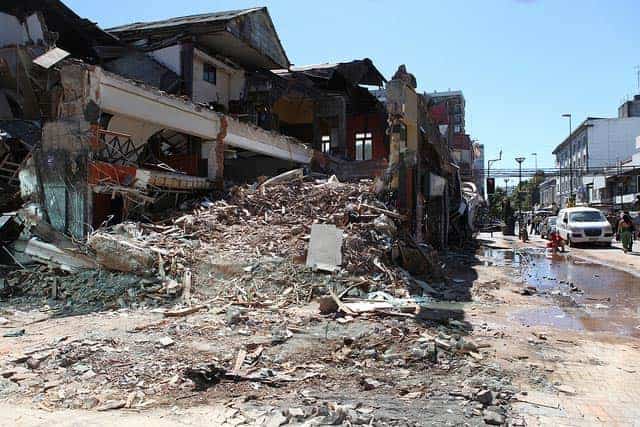
Earthquake preparedness should be just one part of a comprehensive disaster plan, including prepping for other disasters like hurricanes, flooding, and EMPs.
Many earthquake survival steps are the same for other natural disaster types. So, you’ll increase your overall disaster preparedness by taking steps to prep for earthquakes.
These are the most important things you need to know to survive a quake:
Preparedness Matters: The more you prepare, the more likely you will come out alive and uninjured. You’ll also have a less stressful time during the aftermath.
Know-How to Shut Off Utilities: Gas leaks, electrical fires, and burst pipes are common after earthquakes. Shutting off utilities quickly after the quake will prevent/contain these problems.
Identify Safe Places: You might not be able to get to your designated safe place when a quake occurs. Practice situational awareness and learn to identify safe areas wherever you happen to be.
Drop, Cover, and Hold On: Make sure your kids know to do this and have practiced it in drills.
Prepare an Emergency Kit: You’ll need emergency earthquake supplies for your home, vehicle, and work.
Preparedness Before the Earthquake
Surviving an earthquake largely depends on the steps you take before the quake even hits. Start by immediately stockpiling earthquake supplies and build up your preparedness level from there.
1. Stay Informed
Get an NOAA emergency radio with alerts. You can set the radio to your zone and automatically get alerts if a disaster is set to hit the area. You’ll learn about the quake before it makes it to the news.
2. Prepare Your Home for an Earthquake
A bit of prep can prevent damage from falling objects – especially if you cannot get to cover when the quaking starts.
Secure heavy furniture to wall studs
Use safety straps for large appliances
Put latches on cabinet doors to keep contents from spilling outside
Hang items on walls with closed hooks
Attach decorative items to shelves with putty
Keep hazardous chemicals away from the stove
3. Earthquake Survival Supplies
At the very least, you should have a 3-day emergency equipment supply. This includes food, water, a first aid kit, and tools for cleaning up debris.
However, it is better to pack a 30-day supply.
Past disasters have shown that it can take a long time for emergency aid and even longer for stores to restock their supplies. I would rather be safe at home than fight crowds for bottles of water distributed by aid workers!
You’ll need emergency supplies in your home, vehicle, and work or school.
4. Run an Earthquake Drill
Earthquakes don’t build up slowly as hurricanes do. You probably won’t have much time to think about where to go once the quaking starts.
Every second matters. Many people get injured because they hesitate once they feel the earthquake tremors.
Hesitation causes them to waste valuable time and get hurt by falling objects. Emergency earthquake drills are essential because they help you react quickly and appropriately.
Here are some guidelines for running an emergency drill:
Run earthquake drills at least twice yearly
Practice identifying safe places even away from home, such as by asking your kids, “Where would you seek shelter during an earthquake here?”
Talk to your kids’ school about whether they perform any earthquake drills.
Here’s a more detailed guide on how to run an earthquake drill.
5. Communication Plan
One of the biggest prepping mistakes is failing to make an emergency communication plan. After a disaster, phone lines are often destroyed. Mobile phones get flooded, and calls can’t get through.
Imagine if an earthquake hit while you were at work and couldn’t get into contact with your family. It would be incredibly stressful. Even worse, what if a family member was missing? A communication plan can address these issues.
Here is a comprehensive guide on how to make an emergency communication plan.
6. Evacuation Plan
Because we rarely get advanced warnings of earthquakes, it is unlikely that you’ll be able to evacuate before an earthquake hits.
The official advice is: Don’t evacuate before or after an earthquake unless told to do so.
Unless the earthquake has made your location unstable, it is best to remain where you are even after the quake. You risk being caught outdoors during an aftershock if you try to leave. Wait until authorities say it is okay to evacuate.
In case you do need to evacuate your home after an earthquake:
Learn where emergency shelters are in your area
Determine how you would get there and how long it would take
Have a “Bug Out Bag” ready so that you can evacuate quickly
Be prepared to be away from home for several days or weeks
Tsunami Zones and Evacuation
The exception to the rule is if you live in a tsunami zone (see tsunami map here). People in these areas are advised to leave immediately after the quake stops.
Go to higher ground ASAP. It only takes minutes before tsunami waves hit. If you are at home, head towards the upper floor. Outdoors, you might need to climb a tree and HOLD ON.
Check out this real footage of the tsunami in Japan to see why prompt evacuation after earthquakes is necessary.
Survival during the Earthquake
I have only experienced an earthquake once. It wasn’t a large event, but it was still scary as hell. Luckily, we’d run drills so my family and I could take the proper steps to stay safe during the quaking.
1. What to Expect During an Earthquake
A big part of mental preparedness is knowing what to expect. If you’ve never experienced the raw power of an earthquake, I suggest you watch the video below.
You can see that there won’t be much time to get to cover—every second counts.
In the video, note how few people practice Drop, Cover, and Hold On.
One supermarket woman is even trying to hold the shelves up to keep them from falling. Luckily she gave up and hopefully avoided getting smacked in the head with a flying can of soup.
How you react could save your life, so run earthquake practice drills!
2. Safest Place during Earthquake
The problem with earthquakes is that you won’t be able to move far. In a mag 6.5 quake or higher, you’ll be lucky to go 6 feet before the ground shakes too badly for you to stand anymore.
Statistics show that the further you try to move during the earthquake, the more likely you will be injured.
Moving as little as 10 feet during a quake will likely result in injury. (source)
This goes to show how important it is to quake-proof your home. Imagine that you are sitting on the couch when the quake hits. You might have a sturdy desk in the next corner that could serve as a cover – but a bookshelf might topple on you as you try to get there!
Since you can’t move far to safety during a quake, the best thing you can do is: DROP, COVER, and HOLD ON.
Drop
Drop to the ground where you are. This position prevents you from getting knocked off your feet.
Cover
Cover your head and neck with your hands to prevent injury.
In school drills, they had us use textbooks to cover our heads.
If cover such as a sturdy desk or table is nearby, crawl underneath it.
If you cannot find cover, crawl towards an interior wall (one away from windows).
Avoid crawling under any large furniture or wall hangings you did not secure.
Hold On
Don’t be surprised if your cover starts wobbling across the floor during the quake.
Hold on and move with the cover if you must.
Quaking usually lasts just a minute or two.
During an Earthquake Do NOT:
- Go outdoors. Falling debris can kill you. People who go out during a quake often get injured the worst.
- Go under a door frame. This is a common earthquake myth – door frames are not sturdier than anywhere else in your home. You just risk getting hit by flying debris.
- Use the “Triangle of Life” method. This method is based on many incorrect assumptions. You should drop, cover, and hold on instead.
- Go under the bed. Beds do not provide adequate protection against falling debris, and you’ll be trapped in a very tight space if debris does fall on the bed. If a quake hits at night, roll off the bed instead and cover yourself.
3. If Outdoors during an Earthquake
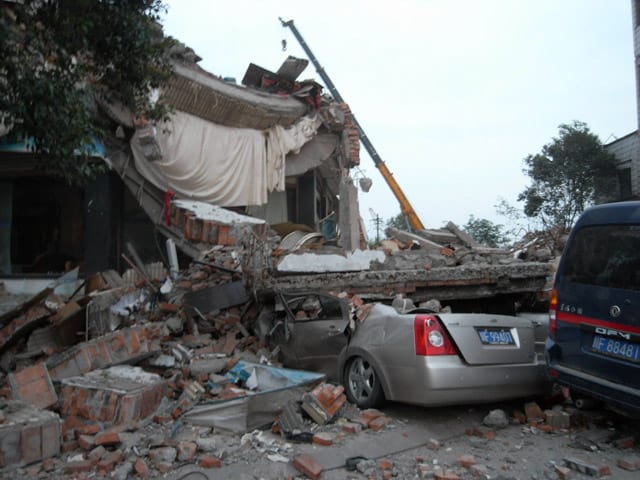
Unless you are lucky enough to be in a wide-open field, being outdoors is one of the worst places to be when an earthquake hits.
Outdoors, you have a lot of things to worry about, like:
- Crumbling facades
- Broken glass
- Electricity poles and wires
- Falling tree branches
Don’t try to rush indoors if a quake hits, though. You’ll just put yourself at risk of getting hit by flying debris.
Instead, look for an open space free of electric poles, trees, and large buildings.
Go there and follow, drop, and cover.
4. If Driving When a Quake Hits
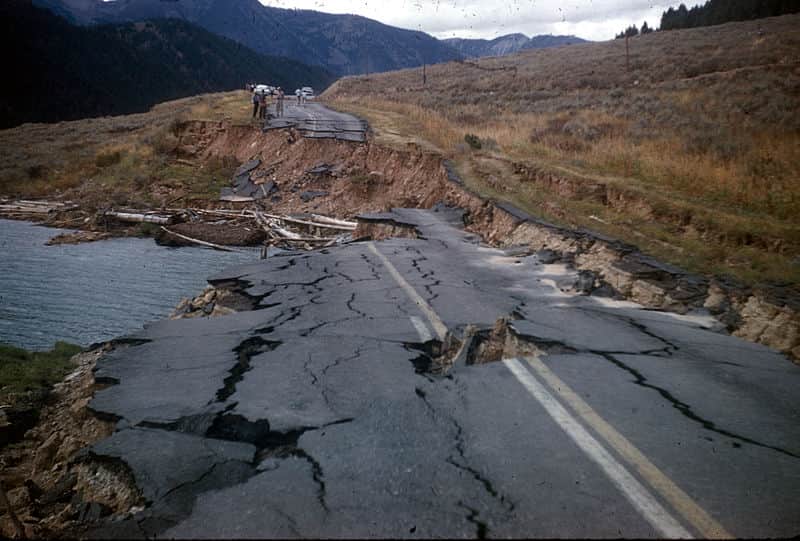
If an earthquake hits while driving, it will probably feel like your car suddenly has severe problems. It might take you a moment to realize it’s an earthquake, not your steering going out of control.
Steps to Take:
Slowly come to a stop
Try to stay away from any trees, poles, traffic lights, or large buildings. You’ll want to avoid bridges during a quake as well!
Turn the vehicle off and put on the parking brake
Stay in your car.
Cover your head. Even in a car, you can still get harmed by falling debris.
Remain where you are even after the quaking stops
Turn on the radio and listen for alerts.
Drive cautiously afterward. Anticipate rubble, broken stoplights, and blocked roads.
5. Stay Calm
It is essential to stay calm during an earthquake. Freaking out has never helped anyone during a survival situation. It just causes poor decisions.
Staying calm is especially important if you have small children, as they will be taking their cues about how to react from you. The event will be less traumatic for them if you can remain calm.
Practice mental preparedness training techniques to help you stay calm during a disaster.
After an Earthquake
1. Prepare for Aftershocks
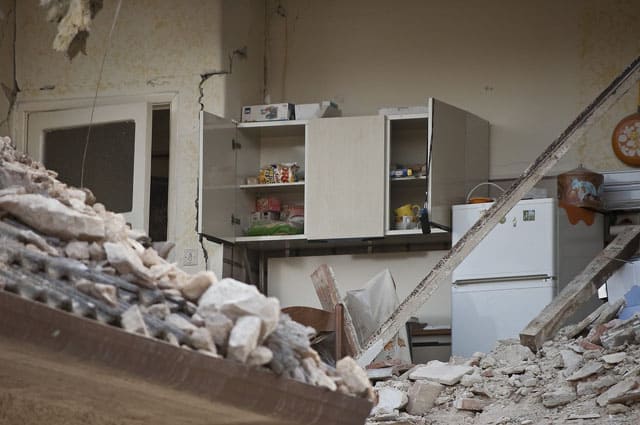
When an earthquake occurs, it destabilizes the entire fault line. The result is that aftershock earthquakes can occur.
The worst case of aftershocks occurred after the 2011 Tohoku earthquake in Japan. The original 9.0 magnitude earthquake hit at 2:46 pm. Just 22 minutes later, a 7.4 mag quake hit. This was followed by two more large aftershocks within 18 minutes.
Large aftershocks continued for weeks after the quake. Even a year later, smaller aftershocks were still occurring.
The bigger the original earthquake, the bigger and more frequent the aftershocks will be.
We don’t know if and when aftershocks will occur. So, you can’t be expected to cower down for weeks in a safe spot. However, you can use extra caution after a quake to ensure you aren’t in dangerous areas – like right next to a building about to topple.
2. Stay Informed
Hopefully, you have stored your emergency radio someplace accessible. It will be your lifeline to the outside world.
Pay attention to whether there are any evacuation notices in place. Always follow the evacuation instructions even if you think you are safe at home. There are dangers you can’t predict (such as chemical spills or nuclear plant meltdowns), which is why authorities make the call.
3. Gas Leaks and Fire Risk after Earthquakes
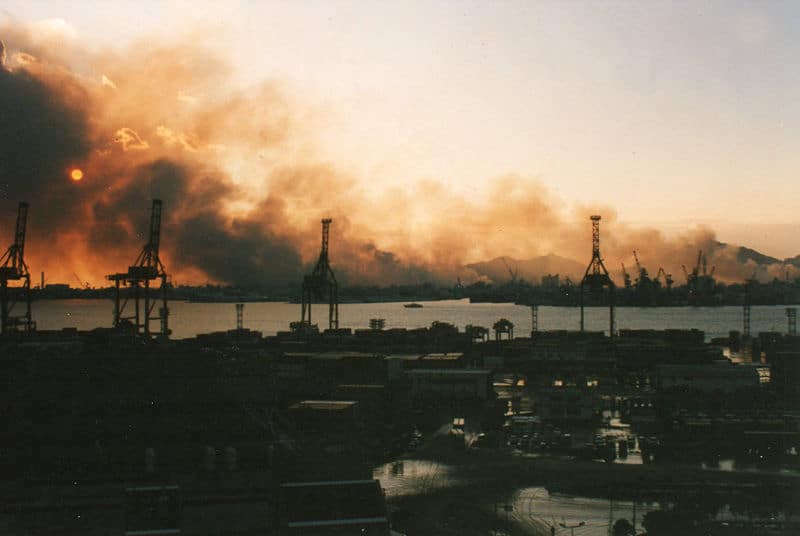
Before we had electricity, earthquakes would almost inevitably result in fires caused by overturned lamps and candles.
Today, the risk of fires isn’t as bad. However, gas leaks can still pose a considerable fire risk.
To stay safe:
Consider an automatic gas shutoff valve: These are set to shut the gas off immediately in situations like an earthquake.
Do not use candles after a quake: An aftershock could overturn the candles. The flame could also ignite leaked gas.
Check for a gas leak: The main sign of a gas leak is that you’ll smell something like rotten eggs in the air. Your gas meter might also be running quickly.
If there is a gas leak: Do not turn on anything electric. Open a window and run outside immediately. Then shut off the gas at the main.
When to turn off the gas:
After shutting off the gas, only the utility provider can turn it back on again. For this reason, utility companies only recommend shutting off the gas if you suspect a leak.
I would play it safe, though, and just shut off the gas – especially if it was a large earthquake and aftershocks were likely or if I was going to evacuate the home.
However, I have an emergency stove and heater, so I could easily live without my gas supply after a disaster.
4. Tap Water after Earthquakes
After a large quake, expect the water mains to be damaged. You might even need to shut off your water main if the quake caused pipes to burst.
Even if tap water still works, it doesn’t mean you should drink it.
Water treatment plants often stop working during emergencies. The water from your taps might be tainted with bacteria, protozoa, or other contaminants.
How to Tell if Tap Water Is Safe to Drink
You can try calling the water company to ask about the tap water, but good luck getting through. The phone line (if it is even working) will likely be flooded with callers.
Instead, turn on your emergency radio and listen for a water update.
If you can’t get any information about the tap water, assume it is unsafe to drink.
Treating Water after an Earthquake
Hopefully, you have enough bottled water for at least three days (though a 30-day stockpile is recommended).
If not, you can use one of these methods for treating water:
Boiling: Bring water to a rolling boil for at least 1 minute.
Filter: A 0.2-micron water filter will remove bacteria, protozoa, parasites, and some chemicals.
Bleach: You can use bleach to treat water. It will kill bacteria, viruses, and other common pathogens.
Recommended Reading:
Bear in mind that every disaster is different. For example, if the quake occurred near a chemical plant, the chemicals could contaminate your water supply.
You need to use a purification method like activated charcoal to remove the chemicals.
It is recommended that you have more than one way to treat water.
Recommended Reading:
5. If You Get Trapped during an Earthquake
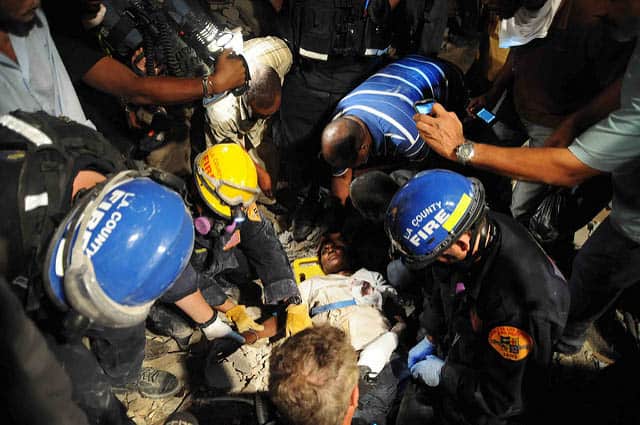
After the earthquake in Haiti, Evans Monsignac found himself trapped under the rubble of a marketplace. He stayed there for 27 days before finally being rescued.
Monsignac barely survived. He had no food, and his only water source came from leaking sewage. When he was found, he had lost 60lbs, his wounds were festering, and he was severely dehydrated.
But he survived. It is incredible what the human body can endure.
There are numerous other earthquake survival stories about people being pulled out of the rubble. If I were ever trapped under earthquake rubble, I’d like to remember these stories to give me hope.
What to Do:
Stay Calm: Screaming will use up your much-needed energy. You’ll need a clear, level head if you want to survive.
Assess the Situation: Are there any injuries? Is there an immediate danger of more falling rubble? Can you see light or feel air? Do you have any supplies, such as water, near you?
Treat Injuries: Put pressure on wounds. Use your clothes to wrap wounds temporarily if needed. Elevate injured parts to reduce bleeding.
Protect Against Dust: Use your shirt to cover your mouth and nose so you don’t breathe in dust.
Find Escape Route: If you can safely do so, start working your way outside the building. Remember that moving debris might cause more rubble to collapse.
Move to More Secure Location: The building might collapse further. Move to a spot that offers more protection, such as under sturdy furniture or a collapsed beam.
Signal for Help: If your phone doesn’t work and you don’t have a whistle, the best way to signal for help is to knock on solid pieces of rubble. Knock three times, wait, and then repeat. Rescue workers listen for these types of sounds.
6. Assist Others
If you’ve survived the earthquake without serious injuries, now is the time to go out and help others.
Start by checking on your neighbors to see if anyone is injured. Join rescue teams who are working to save people trapped under rubble.
Disasters are terrible times, but they also bring out the heroes in us. This is just one more reason to get prepared for an earthquake. You will save yourself and be in a better position to save others.
Learn more about how to become a disaster rescue hero.



After I ordered your reports, I was scrolling through your contents and lost track of the ability to print the reports.
Please send me a link to print the reports!